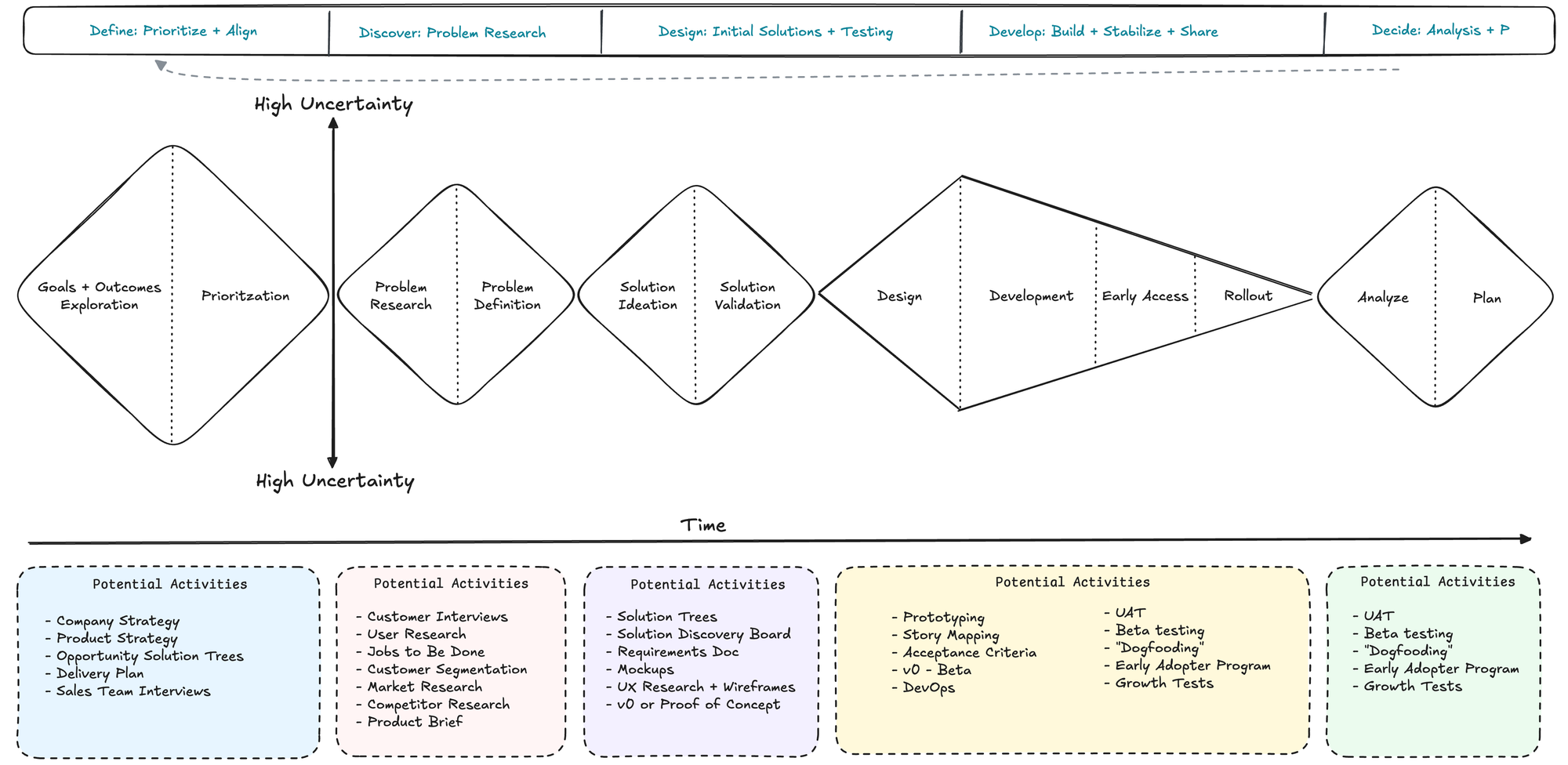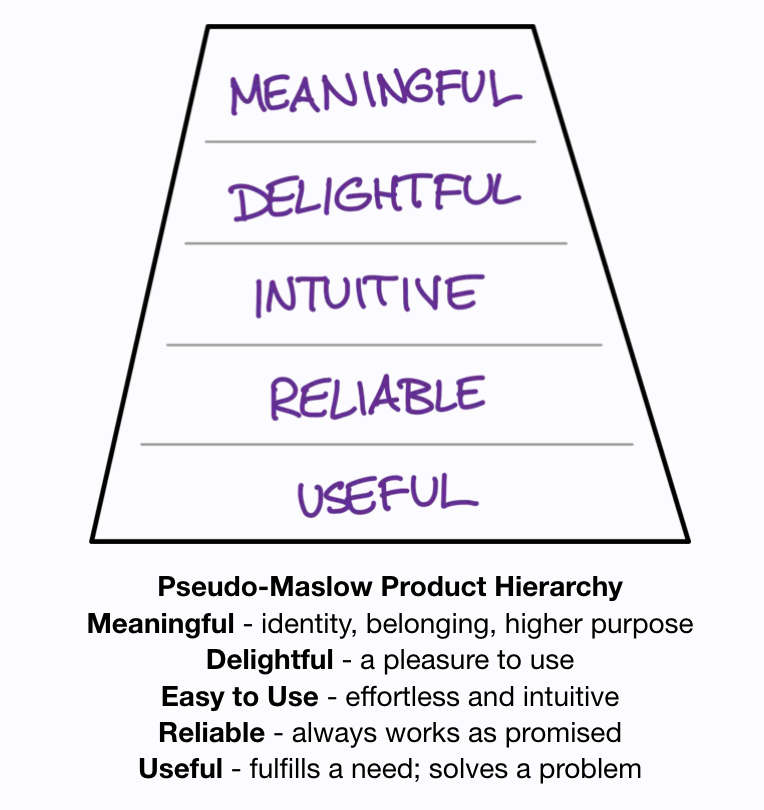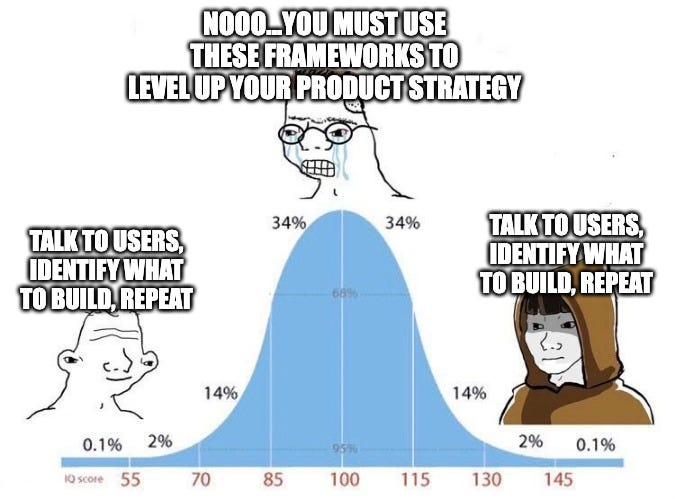"git gud" at Building Products: The 5D Framework

Building products and companies is about managing continuous uncertainty.
You never know enough about the customer, market, competitors, and world at a point in time. Technology and possibilities are constantly changing. The competitors are doing their best to cut you off at the knees and redefine a market. Your customer has personal preferences and is influenced by shifting tastes. It's impossible to understand it all at once.
"Managed chaos" is real in startups and products. The extremes of "plan and research every detail" and "YOLO" aren't the answer - it's somewhere in between.

So what does that look like?
Especially in complex product or startup markets (B2B, data, international B2C) - what do you do?
The 5D Product Framework: An Overview
The Design Council in 2004 released the Double Diamond into the design world. If you have been in design, startups, or marketing - you would be familiar with the Double Diamond.

It's a process of moving from exploring (divergent thinking) to defining (convergent thinking). It's a continuous process - never fully static - moving from discovery to decision then back as needed.
While the framework generally applies to any design scenario (which products and companies are inherently designed), it always struggled when I shared it broadly. The general applicability, a blessing in many ways, can be a curse. The Double Diamond often was met with "ok but how does this apply to me and what next?"
So introducing:
5D Product Framework
Define > Discover > Design > Develop > Decide
This framework is an attempt to put context, flow, and expectations to the inherently fluid process of "deciding what to build".
But the core is simple - talk to users, identify what to build, build, and repeat.

1. Define: Prioritize and Align
The first D is about getting your house in order. Just like in healthcare, you need a diagnosis before treatment. Define is your diagnosis phase.
Key Activities:
- Company + Product Strategy: Setting clear direction and scope
- Quarterly OKRs: Measurable goals that align with strategy
- Opportunity Solution Trees: Mapping problems to potential solutions
Tips for Effective Prioritization:
- Start with the "why" - what problem are you really solving? Why is this important to solve now for your users?
- A prioritization framework (such as RICE) is helpful to combat HiPPO (Highest Paid Person Opinion) issues but don't be a beholden to it. Prioritization requires looking at the full picture and making decisions - even if they seem irrational to someone on the outside
- Focus on one big bet per quarter - don't try to boil the ocean. You will do at best half of what you plan. It's ok.
Remember: There are only two criteria for product success:
- Does it solve a user's problem well?
- Does it help business move forward?
That's kind of it. Sorry 🤷🏻♂️

2. Discover: Problem Research and Solution Validation
- Activities: Customer Segmentation, Customer Interviews, JTBD Mapping
- Balancing problem discovery with solution validation
- Case study or example of successful problem research
This is where the rubber meets the road. Just like in data, garbage in = garbage out.
Key Activities:
- Customer Segmentation: Who exactly are we building for?
- Customer Interviews: What are their actual problems?
- Jobs To Be Done (JTBD) Mapping: What are they trying to accomplish?
The Discover phase is about balancing depth with speed. You're not writing a PhD thesis - you're trying to understand enough to take informed action. Get a sense of the use case and understand it deeply.
Case Study: Marketing Analytics Dashboard
When I was building analytics dashboards at a healthcare marketing agency, everyone wanted to "go big" - build flashy brand launches, complex visualizations, get perfect attribution, integrate external context.
But when we actually talked to users, they just wanted to answer simple questions:
- How are my campaigns performing?
- Where should I allocate budget?
- What's working and what's not?
Users don't "want the data" - they want insights and something to help them make progress in their decisions.

3. Design: Crafting the Product Experience
Design isn't just about making things pretty - it's about making them work. In healthcare tech, this is especially crucial. There is serious "low hanging fruit" in building intuitive data product interfaces and "giving people a dashboard" is not the answer.
Key Activities:
- UX Research: Understanding user workflows and pain points
- Design Sprints: Rapid ideation and validation
- High-fidelity Prototyping: Testing with real users
- Note: don't stop with 2-3 users, getting a diverse set of opinions from your customer personas needs to include 5-10 points of direct feedback. Don't lie to yourself.
The Iterative Process:
- Start simple
- Get feedback
- Refine
- Repeat
Pro tip: KISS (Keep It Simple, Stupid). Accept complexity when necessary, data products especially are by nature complex and you can't avoid this, but lean towards simplicity, design, and empathy. Run from "complicated".

4. Develop: Building and Preparing for Launch
Development is where ideas become reality. But remember - the goal isn't to build everything perfectly. It's to build enough to learn. Shoot for something that is Simple, Loveable, Complete.

Key Activities:
- Story Mapping: Breaking down features into manageable chunks
- QA/DevOps: Ensuring quality and reliability
- UAT: Testing with real users
- Feature Go-to-Market Planning: Preparing for successful launch
Common Pitfalls:
- Over-engineering solutions
- Perfectionism paralysis
- Feature creep
- Forgetting about the end user
5. Decide: Analyzing and Improving
The final phase transforms instincts into evidence, where your data infrastructure proves its real value and insights drive action. Success here means implementing systematic feedback loops that actually inform product decisions, not just collecting data for data's sake.
Customer Interviews: Getting qualitative feedback
- Run structured exit interviews with churned customers while scheduling monthly power user deep-dives to understand what works and what doesn't
- Track feature requests and patterns in a searchable repository, capturing verbatim quotes that illuminate real user needs - Interview Snapshots are gold for sharing this with leadership and others
- Build and maintain systematic feedback loops that connect directly to product planning > back to the beginning. Connect feedback into the Define phase.
Product Metrics: Measuring what matters
- Focus on actionable metrics that drive decisions: time to first value, core action completion rates, feature adoption velocity, and engagement depth scores
- Skip the vanity metrics (if you can) and build real-time dashboards with clear next actions, implementing anomaly detection that catches issues before they become problems
- Connect every metric to a specific product or business outcome that matters
Cohort Analysis: Understanding behavior over time
- Map usage patterns to revenue outcomes and monitor product stickiness to understand what keeps users coming back
- Build cohort analyses that reveal which user characteristics and behaviors predict success

Implementing the 5D Product Framework
Use it. Don't use it. Copy. Adapt it.

The goal is to "decide what to build", build it, and see if the market responds. Rinse and repeat.
Managing Uncertainty and Learning
- Strategies for reducing uncertainty throughout the product lifecycle
- How to maximize learning at each stage of development
- The role of experimentation and iteration in the 5D framework
Conclusion
Building products is hard. Building good products is harder. Building great products requires a framework that balances structure with flexibility.
The 5D Framework isn't perfect - no framework is. But it provides a path through the chaos, a way to manage the endless uncertainty of product development. It's helped me - hope it helps you.
Remember:
- Define, Discover, Design, Develop, Decide > repeat
- Data, LLMs, algorithms, systems aren't magic - they are tools
- Quality matters, especially in healthcare and other regulated industries
- Treat your users, data, and team well, and incredible things can happen
What's your take? How do you manage product development uncertainty? Let me know in the comments.
Additional Resources
Define
- Getting better at product strategy - Lennys Newsletter
- Product Strategy - Reforge
- Mission, Strategy, and Tactics - Boz
- Mission - Vision - Strategy - Goals - Roadmap - Tasks - Lennys Newsletter
Discover
Design
- PM - Design Partnership - Lennys Newsletter
- Building beautiful products - Katie Dill
- What is product design - Figma
Develop
- The engineering mindset - Will Larson
- Making better estimates with engineers - Jason Evanish
- Learning Track: Working with Developers - Technically Substack
